Topic outline
- Waves! Sound! Light! Electricity! Magnetism! It's ALL HERE!
Waves! Sound! Light! Electricity! Magnetism! It's ALL HERE!
Physics B is the second half of the physics curriculum at Clarenceville High School. It covers the major topics in waves, sound, light, electricity, and magnetism. Some details to be covered will be music, lenses and mirrors, electrical circuits, motors and generators.
- Types of Mechanical Waves
Types of Mechanical Waves
All waves carry energy from one place to another. Mechanical waves are waves which travel through a substance, called a medium, and which cause the particles in that substance to oscillate, or vibrate. Particles vibrate, but are not carried along with the wave.
Transverse waves are"s-shaped" waves. The vibrations in a transverse wave are perpendicular to the direction of motion. If the wave is moving to your right, for example, the particles could move up and down, or toward and away from you, but not left or right.
Longitudinal waves are also called compressional waves. The vibrations in a longitudinal wave are along the same direction that the wave travels. If a longitudinal wave is moving to your right, the particles must be vibrating left and right.
- Look at the Wave Animations, and decide what directions the are moving, and what directions the particles are moving for each wave type.
- Transverse waves: highest point = crest, lowest point = trough
- Longitudinal waves: densest point = compression, least dense point = rarefaction
- Surface waves are combinations of transverse and longitudinal. As waves pass under it, a boat bobbing on the ocean actually moves in circles, so it moves both up and down, and side to side.
Great animations and descriptions. Check out the wine glass breaking at the end!
Print first two pages only. Answers are at the end.
Lots of animations which explain waves concepts, from basic to advanced. Check out the index.
- Properties of Mechanical Waves
Properties of Mechanical Waves
- All waves have period and a frequency. The period is the amount of time that passes between identical waves. The frequency is the number of waves in a certain amount of time. The basic unit of frequency is the Hertz (Hz) which equals waves per second. Hertz can refer to anything per second, such as taps per second, or operations per second on a computer chip.
- To get the concept of period, it is useful to study a pendulum, or a mass bouncing on a spring. How long does it take to complete one full back-and-forth or up-and-down?
- All waves have a wavelength, which is the distance from one point on a wave to the matching point on the next wave. (Example - distance from crest to crest, or trough to trough.)
- Big Important Concept: If you increase the frequency of a wave, the wavelength will decrease. Speed = Wavelength x Frequency

-
Khan Academy Video on all the major math of waves (velocity, frequency, period, wavelength)
Thanks to Dr. Dan Russell at Kettering University for his great web site with many animations! http://www.kettering.edu/~drussell/demos.html
- Reflection, Refraction, and Diffraction
Reflection, Refraction, and Diffraction
Reflection is the bouncing of a wave off a surface or boundary. Law of Reflection: The angle of reflection equals the angle of incidence. (Both angles are measured from the normal, which is a line perpendicular to the surface.)
Refraction is the bending of a wave as it passes from one medium to another, and changes speed. Waves which travel along the normal, and hit a boundary head on, will change speed, but they will not change direction. Waves that come it at an angle from the normal will bend. Wavelength changes, but frequency stays the same!
Diffraction is the spreading of a wave beyond a boundary, edge, or obstacle. Check out this Diffraction Animation Applet, which takes a minute to calculate the pattern, but makes a really great animation. Change the wavelength and slit width to see how the diffraction changes.
Set the damping to zero. Make a pulse go down the wave. Notice how it behaves when it hits a fixed end that it can't move.
Change the end to "Loose End", and note the change in behavior. This will be important when we get to sound resonating in a tube.
Trace wave progress with your finger. Note the change in speed.
- Interference, Standing Waves, and Resonance
Interference, Standing Waves, and Resonance
When two waves pass through the same point at the same time, they are said to "interfere". This is not a bad thing - it just means that the resultant wave is the sum of the two waves.
When a wave moving in one direction is reflected directly back over itself, the incident wave and the reflected wave create a standing wave. At some spots, the waves always end up canceling each other, and therefore there is no motion. These points (red dots in diagram below) are called nodes. At other points, the waves are always identical (crest meets crest or trough meets trough) and there is maximum motion. These points are called antinodes.
 Standing waves will resonate, or get larger, if the correct frequency is used. That frequency depends on the size and type of object constraining the wave. Guitar strings and slinky toys can form obvious transverse standing waves, but longitudinal, or compressional, waves can also form standing waves. Blow across the top of an empty bottle!
Standing waves will resonate, or get larger, if the correct frequency is used. That frequency depends on the size and type of object constraining the wave. Guitar strings and slinky toys can form obvious transverse standing waves, but longitudinal, or compressional, waves can also form standing waves. Blow across the top of an empty bottle!A wave which is contained in some sort of tube or cavity may have just the right wavelength so it has constructive interference, and reinforces itself, getting larger and larger. This condition is called resonance. The frequencies which create the right wavelengths for this to happen are called resonant frequencies. This concept is extremely important for musical instruments such as flutes and trumpets
Superposition is the term for one thing being laid over top of another. If a standing wave and reflected wave are combined, or superimposed, then the sum can be a standing wave.
Press start to see the standing wave created when you oscillate the end of a long spring which is held at the other end.
This applet shows the pressure and displacement variations as air resonates inside a tube (such as a trumpet or organ pipe. Note that there are many frequencies and wavelengths that will resonate, and that as the frequency increases, the wavelength decreases. This is why short instruments can only make high pitched notes.f\
Adjust the various settings on the right, and follow the motion of individual particles in the tube.
- Resonance and Natural Frequency
Resonance and Natural Frequency
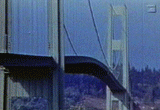 Natural Frequency: The frequency at which an object naturally vibrates. (surprise.) Instead of an object, it could also be a sound or light wave going back and forth in a cavity or space.
Natural Frequency: The frequency at which an object naturally vibrates. (surprise.) Instead of an object, it could also be a sound or light wave going back and forth in a cavity or space.Resonance:
The increase in amplitude of a wave, due to applying a force at the proper natural frequency.
Example: If you push a person on a swing at the natural frequency, (with the proper timing), then you can get that person swinging very high, even if you only give them a small push each time. If you push with the wrong frequency, then you will just be hitting them in the back at random times, and they will not move very far.
Dictionary definition:
Physics: The increase in amplitude of oscillation of an electric or mechanical system exposed to a periodic force whose frequency is equal or very close to the natural undamped frequency of the system.
Check out the Longitudinal Standing Waves applet, and select one side open. This will help you visuallize what is happening as the sound waves resonate in the tube during your lab.
This is one of the most famous engineering failures in history!
Grab the yellow dot and try to move the green platform to get the mass oscillating on the spring
Do the problems and click on the arrows to check your answers
- The Doppler Effect
The Doppler Effect
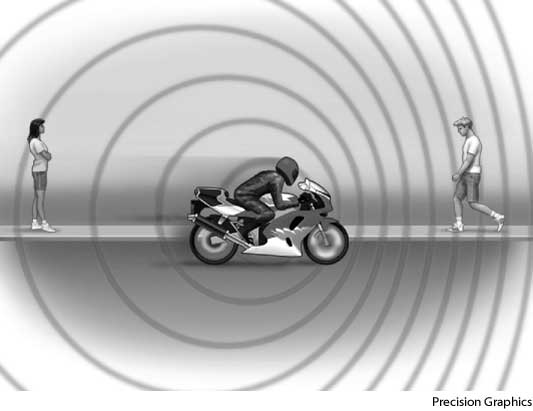 The Doppler Effect is the change in the measured frequency of a wave, caused by the relative motion of the source and the receiver. In more basic terms, if something making waves is coming towards you, you will sense a higher frequency (and shorter wavelength)than it is actually sending out. If something is going away from you, you will sense a lower frequency (and longer wavelength) than it is actually sending out.
The Doppler Effect is the change in the measured frequency of a wave, caused by the relative motion of the source and the receiver. In more basic terms, if something making waves is coming towards you, you will sense a higher frequency (and shorter wavelength)than it is actually sending out. If something is going away from you, you will sense a lower frequency (and longer wavelength) than it is actually sending out. - Beats
Beats
Beats are caused when two waves at slightly different frequencies interfere with each other. The waves alternate between being in phase with each other (constructive interference) and out of phase (destructive interference). This causes the amplitude to alternate between being larger or smaller.
When the waves are sound waves, we hear this as a "Wah Wah Wah" pulsing sound.
Beats are also important in other applications, and occur with all kinds of waves.
Adjust the freqencies of the Red and Green Waves. The sum of those waves is the yellow wave. Why does the yellow wave get larger and smaller? What happens when the red and green waves are set to the same frequency?
When two guitar strings are slightly out of tune, you hear a "warble", or pulsing. Adjusting the tension on the string adjusts the frequency until the strings are playing the same note. Beats are caused by a difference in frequency, so when there are no beats, the strings are at the same frequency.
Listen to each wave, and see if you can tell the difference. Then listen to the waves played together.
- Electromagnetic Waves, Light, and Color
Electromagnetic Waves, Light, and Color
Electromagnetic waves include frequencies which are visible to us, which we call "Light", and frequencies too high or too low for our eyes to sense. We give these frequencies other names such as "radio" or "gamma", but they function the same way, and travel through space at the same speed.

One of the top ten experiments of all time. Proved in 1801 that light behaved as a wave, interfering with itself.
- Color Vision
Color Vision
Humans have retinas which sense light. Some cells in the retina, called "cones" sense specific colors. The three colors to which humans are most sensitive are Red, Green, and Blue. (wavelengths 564 nm, 533 nm, 437 nm) The cells in the eye which work better in dim light, and do not sense color very well, are called "rods".
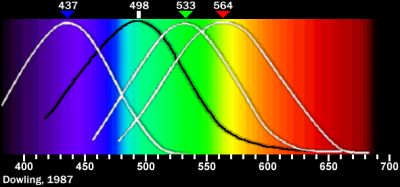
- Reflection, Refraction, and Dispersion of Light
Reflection, Refraction, and Dispersion of Light
Light waves can change direction by bouncing off of a surface, or by bending as they pass from one medium to another. These two processes explain how we can see things around us.
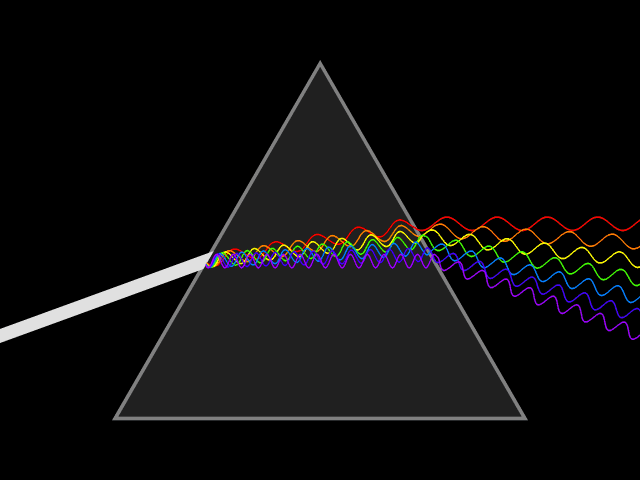
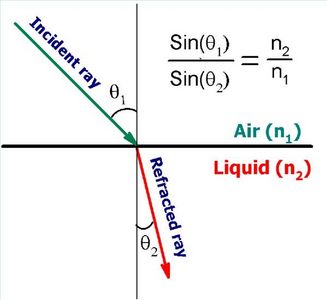
Note that when the angle of refraction would exceed 90 degrees, the beam is not refracted, and is instead totally reflected inside the denser medium.
- Optics, Mirrors, and Lenses
Optics, Mirrors, and Lenses
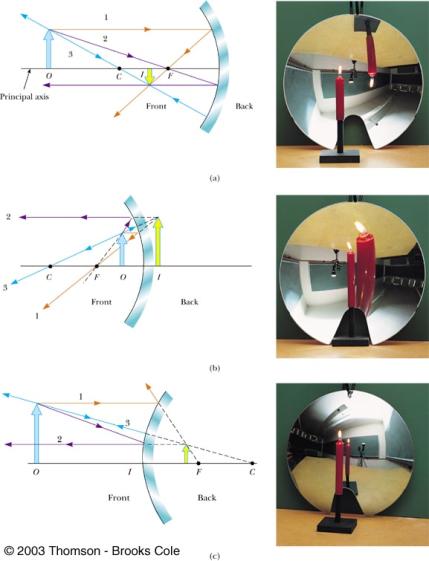
- Topic 12This topic
Topic 12
Chapter 20: Static Electricity, Current, and Circuits
Important Concepts: Electric Charges and Forces; Voltage; Current; Circuits; Ohm's Law
- Topic 13
Topic 13
Chapter 1: Science Skills
Major concepts:
Branches of Science
Scientific MethodObservations - Problem - Hypothesis - Experiment - Data - Results - Conclusion - check Hypothesis and keep the cycle going.assignment: Scientific Method in the Real WorldMetric System and Scientific Notation
Units (gram, second, meter, liter, etc.)
Major Prefixes: Mega = million kilo = 1000 centi = .01 milli - .001(Scientific Notation tutorial in the textbook Math Skills appendix)
Scientific Notation is just a convenient way to express very large or very small numbers.Precision and Accuracy
Precision is how exact a measurement is, or the smallest unit used in the measurement; for example, if you measure someone's weight rounded off to the nearest ten pounds ("160 pounds"), it is useful, but a measurement to the nearest half pound ("158.5 pounds") is more precise. Precision is limited by the measuring tool used. Accuracy is how correct an answer is, or whether it agrees with the accepted value. An answer can be very precise, but not accurate, and therefore not very useful. Example: "The height of the ceiling in the classroom is 5 feet, 2 and 3/16 inches." Very precise, but completely inaccurate, and WRONG!Graphing
- Topic 14
Topic 14
ACT and MME prep - Topic 15
Topic 15
Data Collection and Analysis - Topic 16
Topic 16
Review for Final Exam - Topic 17
Topic 17
Chapter 21: Magnets and Electromagnetism
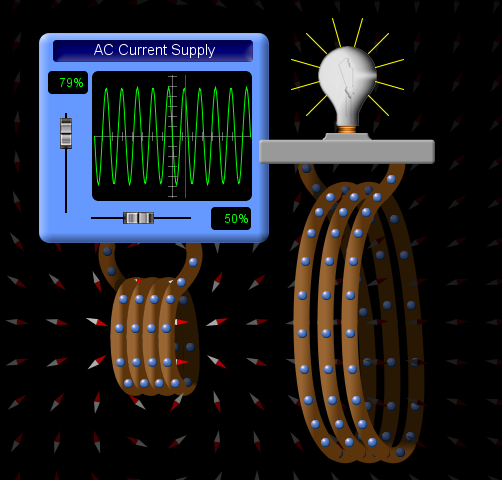
Find out what runs your world!
Important Concepts: Magnetic poles and fields; Induction; Motors, Generators, and Transformers
- Topic 18
Topic 18
- Topic 19
Topic 19
- Topic 20
Topic 20
- Topic 21
Topic 21
- Topic 22
Topic 22
- Topic 23
Topic 23
- Topic 24
Topic 24
- Topic 25
Topic 25
- Topic 26
Topic 26
- Topic 27
Topic 27
- Topic 28
Topic 28
- Topic 29
Topic 29
- Topic 30
Topic 30
- Topic 31
Topic 31
- Topic 32
Topic 32
- Topic 33
Topic 33
- Topic 34
Topic 34
- Topic 35
Topic 35
- Topic 36
Topic 36
- Topic 37
Topic 37
- Topic 38
Topic 38
- Topic 39
Topic 39
- Topic 40
Topic 40
- Topic 41
Topic 41
- Topic 42
Topic 42
- Topic 43
Topic 43
- Topic 44
Topic 44
- Topic 45
Topic 45
- Topic 46
Topic 46
- Topic 47
Topic 47
- Topic 48
Topic 48
- Topic 49
Topic 49
- Topic 50
Topic 50
- Topic 51
Topic 51
- Topic 52
Topic 52